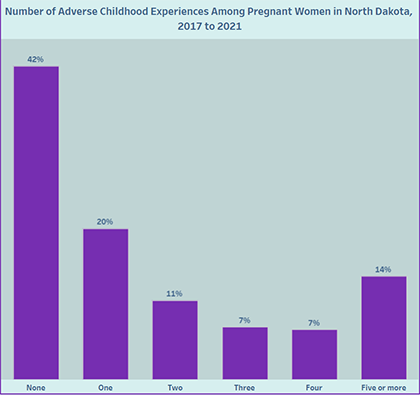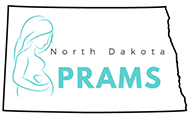Ask A Researcher
August 2023
The Lasting Impact of Maternal Childhood Trauma

The North Dakota Health and Human Services Agency and the Center for Social Research (CSR) at North Dakota State University (NDSU) continue their collaboration with the North Dakota Pregnancy Risk Assessment Monitoring System (PRAMS). PRAMS is a project that focuses on gathering state-specific data on maternal attitudes and experiences before, during, and shortly after pregnancy to improve the health of mothers and infants – with the overall goal of reducing infant morbidity and mortality. To help disseminate project results, a series of dashboards referred to as PRAMS Points are available on a variety of topics including oral health, diabetes, safe sleep, and adverse childhood experiences.
This article supplements the newly released dashboard on Maternal Adverse Childhood Experiences. The dashboard uses data from North Dakota PRAMS gathered from 2017 to 2021 to examine the prevalence of maternal adverse childhood experiences and the associated maternal characteristics and outcomes related to adverse experiences as children. Dashboards such as this, contribute to the ongoing surveillance efforts that can identify populations at risk and help create and evaluate programming and policies to improve health outcomes for pregnant women, babies, and mothers.
Karen Olson is a research specialist with the CSR and provides support for the PRAMS project and North Dakota Compass.
What are Adverse Childhood Experiences (ACEs)?
In the late 1990s, a landmark study revealed a powerful relationship between serious, negative events in childhood and people’s physical and mental health in adulthood. Known as the Adverse Childhood Experiences (ACE) Study, and conducted by the Centers for Disease Control and Prevention and the health maintenance organization Kaiser Permanente, this study asked adult patients to disclose some potentially traumatic events they may have experienced before the age of 18. Researchers asked specifically about 10 experiences – events such as living with a family member with a mental illness or witnessing or experiencing violence – and then looked to see how the number of adverse childhood experiences tracked with a wide variety of adult health outcomes (1).
Some of what they found fit with what was already known — people who had experienced abuse or neglect as children were more likely to have mental health problems as adults. But other findings were surprising, such as the realization that there was a clear, graded relationship between early adversity and physical health. Experiencing a single serious event in childhood seemed to have few or no observable long-term consequences. But multiple forms of adversity in childhood predicted multiple health problems in adulthood.
Maternal ACEs are of special interest since these potentially traumatic experiences as children can impact the health of both mothers and their babies – affecting the next generation. Nationally, in 2021, about one-fourth of individuals experienced at least three adverse experiences as children (28%). For women who were pregnant, the percentage rose to 37% (2). Research has also found that parents with greater exposure to ACEs are more likely to have children with behavioral health problems (3).
A greater understanding of the relationship between ACEs and maternal health outcomes in North Dakota is necessary to focus and improve patient-provider discussions before, during, and after pregnancy — and can lead to clinical, community, and systems-level interventions to lessen harms associated with adverse childhood experiences.
Types of Adverse Childhood Experiences
Adverse childhood experiences are preventable, potentially traumatic events that occur in childhood, including neglect; experiencing or witnessing violence; and growing up in a household with substance use, mental health problems, or instability because of parental separation or incarceration.

From 2017 to 2021, parental separation or divorce was, consistently, the most common ACE reported by North Dakota women giving birth, followed by exposure to alcohol and drug use, experiencing emotional abuse as a child, and mental illness in their home while growing up.
Multiple Adverse Childhood Experiences
From 2017 to 2021, the majority of women giving birth in North Dakota experienced at least one adverse experience as a child (58%). At least one-fourth of pregnant women, on average, reported three or more ACEs; one in five experienced at least four.

While there was little change in the distribution of the number of ACEs over the past five years, the data suggest that North Dakota women giving birth in 2021 are slightly more likely to have multiple ACEs than mothers giving birth in 2017.
Maternal Characteristics
Considering the most current data, mothers giving birth in 2021 who were most at risk for having multiple ACEs included those who were younger, unmarried, and indigenous, as well as those who had little education, lower household incomes, and lived in rural areas. Specifically, the prevalence of three or more ACEs among North Dakota mothers giving birth in 2021 was:
- Age: Higher among teenage mothers (76%) than mothers ages 20 to 34 (29%) and mothers ages 35 and older (17%).
- Education: Higher among mothers with a high school education or less (50%) than mothers with some college education or an Associate’s degree (35%) and a Bachelor’s degree or higher (12%).
- Marital Status: Higher among unmarried mothers (45%) than mothers who were married (22%).
- Household Income: Higher among mothers with household income of $24,000 or less (48%) than mothers with household income of $85,000 or more (20%).
- Location: Higher among mothers living in rural areas (33%) than mothers living in urban areas (26%).
- Race: Higher among indigenous mothers (47%) than white mothers (29%).
- Hispanic Origin: Higher among Hispanic mothers (42%) than non-Hispanic mothers (28%).
Maternal Health Outcomes
North Dakota women giving birth in 2021, who experienced three or more adverse experiences as children, were at greater risk for an unintended pregnancy, depression, and for being physically abused. Specifically, when compared to North Dakota women giving birth in 2021 with no ACEs, women with three or more ACEs were:
- Intendedness:
Three times more likely to have a pregnancy that was unintended (either they wanted to be pregnant later or not at all) (29% compared to 10%). - Depression:
Three times more likely to experience depression prior to pregnancy (45% compared to 14%). Four times more likely to experience depression during pregnancy (39% compared to 9%). Four times more likely to experience post-partum depression (22% compared to 5%). - Abuse:
Much more likely to be physically abused by someone 12 months before becoming pregnant (9% compared to 0%). Much more likely to be physically abused by someone during pregnancy (6% compared to 0%).
Opportunity to Address ACEs
Nearly all pregnant women in North Dakota participating in PRAMS received on-time prenatal care, regardless of the number of ACEs (89% of mothers with no ACEs compared to 87% of mothers with three ACEs or more in 2021). As a result, health care providers have a unique opportunity to address ACEs and reduce their impact on the health of mothers by administering ACE screenings before, during, and after pregnancy — to ensure that mothers receive the appropriate care, support, and assistance necessary. This is particularly important for women who have endured multiple ACEs, given their increased risk of depression before, during, and after pregnancy.
Conclusion
The results of this analysis demonstrate the lasting impact of maternal childhood trauma on the well-being of mothers. Further analysis of ND PRAMS ACEs data along with other maternal behaviors and infant outcomes will help establish a more robust base of information on the impact of maternal ACEs in North Dakota.
Explore the new PRAMS Points Dashboard on Maternal Adverse Childhood Experiences to find more data and information on this topic!
References
(1) National Center for Injury Prevention and Control, Division of Violence Prevention, CDC-Kaiser Permanente Adverse Childhood Experiences (ACE) Study. Information available at https://nhttac.acf.hhs.gov/soar/eguide/stop/adverse_childhood_experiences OR https://www.cdc.gov/violenceprevention/aces/about.html
(2) National Center for Chronic Disease Prevention and Health Promotion, Division of Population Health, 2021 Behavioral Risk Factor Surveillance System (BRFSS). Dataset retrieved from https://www.cdc.gov/brfss/data_documentation/index.htm
(3) Adam Schickedanz, MD; Neal Halfon, MD; Narayan Sastry, PhD; Paul J. Chung, MD. Parents’ Adverse Childhood Experiences and Their Children’s Behavioral Health Problems. Pediatrics, Volume 42, Issue 2. Available at https://www.ncbi.nlm.nih.gov/pmc/articles/PMC6317990/pdf/nihms-998240.pdf.
About PRAMS
More information about the PRAMS project and PRAMS data can be found at www.hhs.nd.gov/prams.
Explore the NEW PRAMS Points Dashboard today!

Other PRAMS POINTS
• Pregnancy and Oral Health (May 2021)
• Gestational Diabetes (July 2022)
• Babies Safe Sleep (August 2022)
• Preexisting Diabetes (December 2022)
